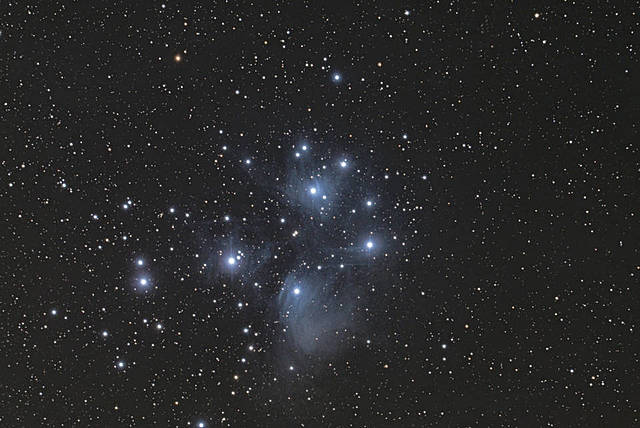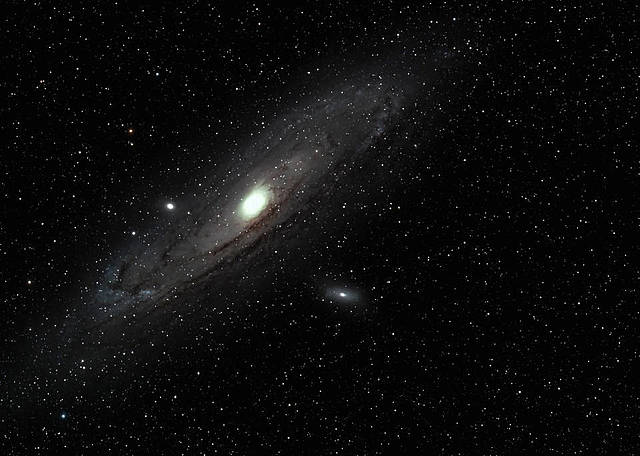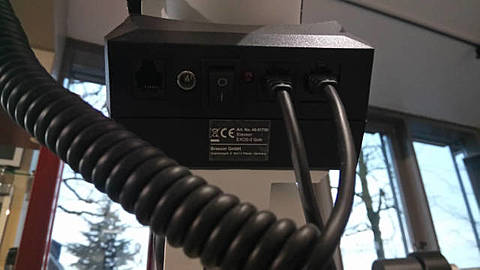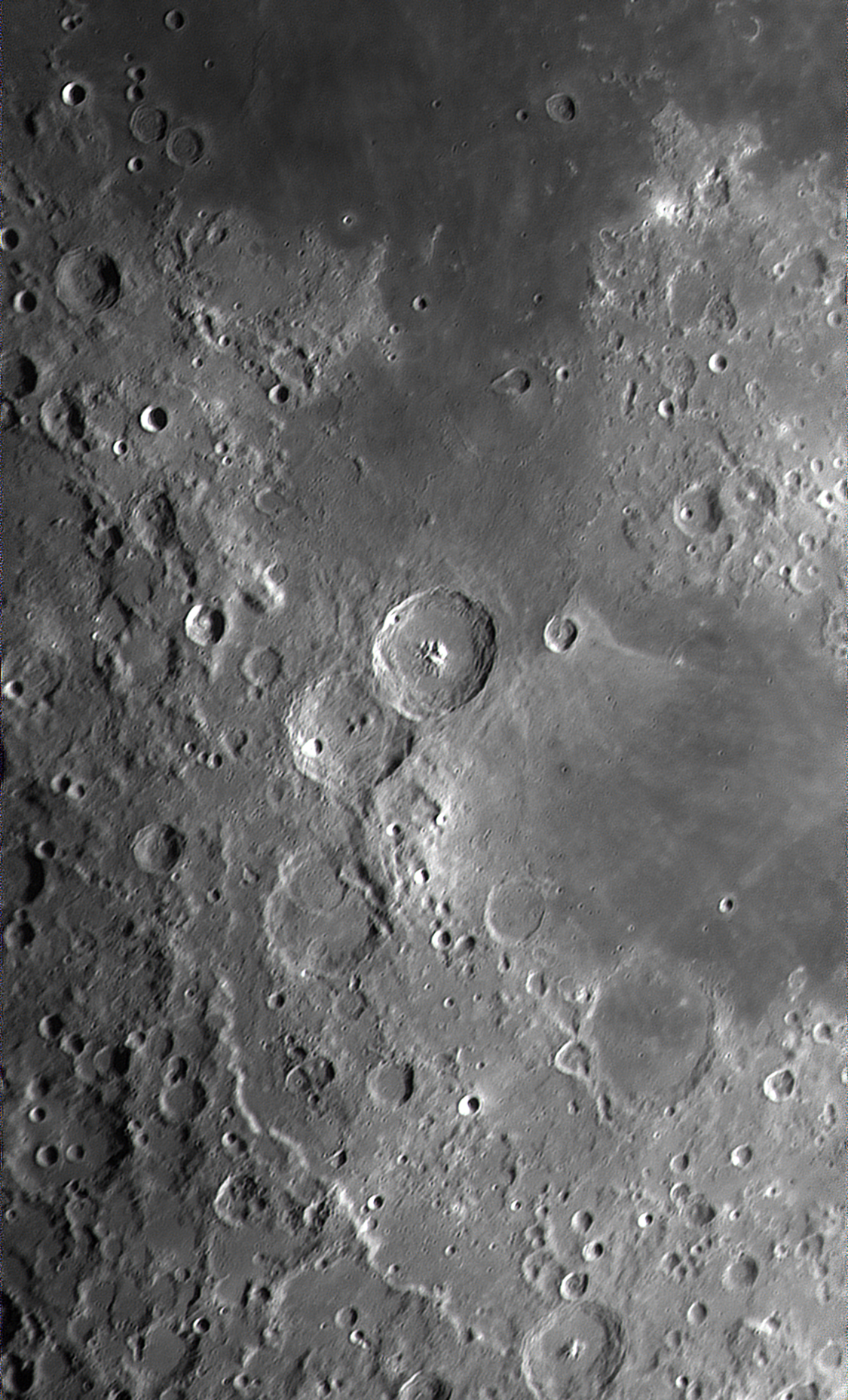Solid equatorial mounted 102mm achromat with Goto Mount
- Achromatic refractor + equatorial GoTo mount
- D= 102mm; F= 600mm; F-ratio: F/5.9
- Equatorial EXOS-2 GoTo mount with motors + Startracker handbox
- Precision mount with ball bearings in all axis and polar finder scope with optional illumination
- Included: Messier AR-102s, EXOS-2 Goto, Acc.
- Modern goto-system with big matrix-display
- Telescope for night and solar observation
- Aperture Solar-filter and smartphone adapter for celestial navigation included
- Excellent HEXAFOC focuser with 65mm diameter
- Cradle rings with handle and camera holder included
Die BRESSER EXOS 2 Goto Montierung
von Jochen Fehmer
Mein neustes Testobjekt ist die BRESSER EXOS 2 Goto Montierung. Nun ja, in der Astronomie- Szene ist sie nicht gerade als die Montierung schlechthin bekannt und die Meinungen gehen weit auseinander.
Also ab ins Lager und eine BRESSER EXOS 2 Goto auf die Sackkarre und ins Auto damit. Mir fiel auf, die Dimensionen des Kartons sind echt übersichtlich, kein langer schwerer wie ich es von anderen Montierungen gewohnt bin. Es sei gesagt, es war keine überprüfte oder eine ausgesuchte, es war eine von der Stange oder besser gesagt vom Regal.
Zuhause angekommen und gestärkt von einem Abendessen machte ich mich ans Werk.
Ich packte die Montierung im warmen Wintergarten aus, denn draußen war es schon sehr kalt, minus 4 Grad. Als erstes das Stativ. Es ist aus Stahlrohr, leicht und mit zwei Feststellschrauben pro Fuß…das finde ich schon einmal gut. Trotz des leichten Gewichts scheint es sehr stabil zu sein. Dann kam der Montierungskopf; die Motorenabdeckungen sind aus Kunststoff. Egal, wenigstens sind die Zahnräder und die Kugellager einigermaßen vor Staub und Feuchtigkeit geschützt. Auch da fiel mir auf, dass die Montierung sehr leicht ist. Die Montierung auf das Stativ zu schrauben ist sehr einfach, eine große Drehstange erleichtert das ungemein. Gute Idee,wenn es draußen nicht gerade warm ist. Dann die Gewindestange an die Montierung geschraubt. Ein Gewicht ist im Lieferumfang enthalten, dass auf die Stange geschoben und fest gezogen. Handbox angeschlossen und das DEC. Kabel installiert. Fertig. Die BRESSER EXOS 2 GOTO Montierung macht so einen guten Eindruck, alle Schrauben sind groß genug um auch mit Handschuhen bei niedrigen Temperaturen arbeiten zu können. Allein vom Aussehen gefällt sie mir sehr gut.
Aber, gut aussehen reicht nicht. Leider suchte ich vergeblich nach einer Polsucherbeleuchtung. Diese muss als Zubehör gekauft werden. Dafür bekommt sie keinen Applaus. Es geht zwar auch ohne, aber mit der genauen Einordnung fällt und steht die Beobachtungsnacht. Schade.
Ich habe das mitgelieferte Batteriefach mit Batterien gefüllt. Ich wollte so damit arbeiten wie sie ausgeliefert wird. Ein Netzteil kann man als Zubehör erwerben.
Auf geht’s, Montierung angestellt. Als erstes fiel mir das sehr große Display der Handbox auf. Sehr angenehm die Infos zu lesen. Keine Laufschrift sondern stehende Buchstaben. Die Umstellung auf unsere deutsche Sprache ist kein Problem. Nur dass die Schrift auf einmal viel größer wurde….warum dieses? Keine Ahnung, eventuell sind viele Deutsche kurzsichtig. Die Zeit und das Datum musste ich nicht mehr eingeben, bei Bresser werden die Montierungen mit dem Goto versehen, so dass alles schon eingegeben wurde. Auch hier ist zu beachten wenn es eingegeben werden muss, erst das Jahr, Monat und dann den Tag. Nun zum Standort: Vorgegeben sind etliche Länder und Städte. Da es aber keine Updates mehr gibt kann man eigentlich sofort damit beginnen seinen eigenen Wohnort einzugeben. Dafür einmal nach unten mit den Pfeiltasten.
Längen,- und Breitengrad eingeben. ( Wenn man den nicht weiß einfach im Internet oder Handy gucken ), Zeitzone hier in Deutschland ist 01. Wenn alles eingegeben ist bestätigen und das ist erledigt. Jedes Mal wenn man nun die Montierung ein schaltet nur noch auf Benutzerstandort gehen und fertig. (interne Batterie). Ich hatte für die erste gemeinsame Nacht mir folgendes vorgenommen.
Doppelschiene und 200 mm Canon Objektiv mit einer Canon EOS 6 D und 8x50 Sucher mit einer ASI ZWO 120 Guiding mit PHD2. Normalerweise sollte man die Montierung in DEC. und RA. auf vorgegebenen Pfeile stellen, dieses wollte ich aber nicht. Ging ja auch nicht, da ich mit einer Doppelschiene arbeiten wollte. Also ausgerichtet und angeschaltet. Ich wollte eine 3 Sterne Ausrichtung machen. Machte ich dann auch, einfach der Sternvorschläge ohne Widerworte folgen. (Wie in einer guten Ehe, keine Widerworte) Drei Sterne durch und fertig. Ich habe keine Ahnung ob das richtig war, schließlich war ich noch im warmen Wintergarten.
Zum Schluss sollte sie auf Home Position fahren, das tat sie auch mit der Querstellung meiner Ausrüstung. Natürlich habe ich vorher das Gewicht der Kamera, Objektiv etc. genau ausgependelt. Das ist sehr wichtig, die Gewichtsverteilung sollte schon passen. Dann ging es raus in die Dunkelheit und in die Kälte.
Die BRESSER EXOS 2 Goto Montierung grob nach Norden ausgerichtet. Nun die Montierung mittels Dosenlibelle auf dem Stativ in Waage gebracht. Dann den Deckel des Polsuchers abgezogen, den Schraubdeckel entfernt. Da keine Polsucherbeleuchtung dabei war habe ich eine Laptop Lampe genommen. Ist eine kleine LED Leuchte mit Klemme und flexiblen Arm…ist zwar kein Rotlicht, geht aber auch. Es geht auch mit der Hand box! In der Hand box vorne ist ein Rotlicht eingebaut mit verschiedenen Helligkeitsstufen. Ohne Probleme reicht die Länge des Kabels aus um in die Öffnung des Polsuchers zu leuchten. Hab ich ausprobiert, klappt. Bei der BRESSER EXOS 2 GOTO ist in der Mitte ein Strich und dort ein Kreis. Da steht Polaris. Es gibt zahlreiche APPs für das Handy. Unter anderem auch die APP- Polarfinder. Diese benutze ich immer. Automatisch habe ich die Position von Polaris. Bitte positionieren Sie den Polarstern auf den Kreis, nicht in dem Kreis. Sie können sicher sein, es passt. Ohne viel Mühe ist das erledigt.
Dann habe ich die Kamera angeschlossen und den Laptop gestartet. Die Scharfstellung ist schon eine heikle Sache. Ich nehme immer den Polarstern. Bis jetzt hat es immer geklappt. Es wäre schade, wenn die ganzen Aufnahmen unscharf oder die Sterne Donuts gleichen, die Zeit sollte man sich nehmen. Zahlt sich später aus.

Foto von Jörg Ortmann aus Hamm-Pelkum , 5.12.2016 (M 45 mit der BRESSER EXOS 2 GOTO, 24x300 Sek., ISO 400 , Canon EOS 1000 Da.)
Die BRESSER EXOS 2 Goto Montierung sollte beim ersten einrichten nur zwei Sterne anfahren, erster Stern war fast in der Mitte des Kameradisplays. Okay, ich gebe zu es war ja das Canon 70-200 mm, F4 Objektiv. Da wäre es sehr traurig wenn ich den nicht gesehen hätte, oder? Beim zweiten Stern viel ich aus den Wolken, die Montierung schlug den Polarstern vor. Alles klar! Doch ich zentrierte unsern Nordstern und bestätigte die Auswahl der Montierung. Da war ich mal gespannt. Ich scrollte auf der Handbox auf den Menüpunkt Messier Objekte und tippte die Zahlen 4 und 5 ein. Die Plejaden sollten es werden, das erste Objekt welches jemals die Montierung angefahren hat…..ein Stück Geschichte. Auf ging’s, sehr langsam und ruhig fuhr die BRESSER EXOS 2 Goto den Himmel ab. Das Motorengeräusch ist ruhig, es wird keinen Ärger mit Nachbarn geben. Und dann war meine Überraschung sehr groß, mittig strahlten die sieben Schwestern im Display der Canon 6D Kamera. Der Adler ist gelandet! Oha, das ist doch mal was, innerliche Freude machte sich breit. Doch wie wird es weitergehen? Also, M 31 die Andromeda Galaxie….ist ja nicht weit weg, 31 in dem Menüpunkt Messier Objekte eingetippt und bestätigt. Und siehe da, M 31 in der Mitte. Dann wurde ich übermütig, Deneb im Sternmenü eingegeben, Mittig. Vega eingegeben, wieder mittig. Warum fragte ich mich, denn innerlich hatte ich mich auf Frust eingestellt. Okay, sie wollte es wissen. Ab zu den Plejaden. Eine Minute Belichtung ohne Guiding. Ergebnis: Punktförmige Sterne. 120 Sekunden eingegeben und Belichtung gestartet.
Kurz in die Küche gegangen und einen Kaffee geholt. Da hatten die Sterne leichte Tropfen. Aber gut. Jetzt wollte ich mal loslegen mit der Fotografie. Ich benutzte ein 9x50 Sucher mit einer ZWO ASI 120. APT auf meinem Laptop unterstützt die Astrofotografie. Im Display von APT stellte ich M 45 nochmal richtig scharf, durch die Zoom Funktion eine tolle Sache.
Leider merkte ich die Himmelqualität lies langsam aber sicher nach. Feuchtigkeit machte sich breit und das Seeing wurde von spitze zu überhaupt nicht mehr spitze! Aber egal, es gab aber noch ein paar Einstellungen die ich machen sollte und zwar die Guiding Geschwindigkeit bei der BRESSER EXOS 2 Goto auf 0,500 ändern. Bei PHD habe ich die Kalibrierungsschritte auf 1000 reduziert. Das waren nur grobe Änderungen, ein Feintuning wird es erst bei den nächsten Tests geben. Nun habe ich die BRESSER EXOS 2 Goto mit meinem Laptop verbunden. Ich habe mir einen passenden Stern ausgesucht und die beiden Sachen sich einrichten lassen. Fertig. Die Ausschläge der Korrektur hielten sich in Grenzen. Also gut, dachte ich und wechselte in mein Belichtungsprogram. Ich stellte ISO 400 ein, 180 Sekunden Belichtungszeit und insgesamt sollten 30 Aufnahmen gemacht werden, also 2 Stunden. Ich startete die Aufnahmen. Ich war gespannt, denn man kann live die Korrekturen des Guiders sehen. 0,30 -0,85, in dem Bereich lagen die Zahlen. Das ist jetzt echt völlig in Ordnung, obwohl ich von anderen Montierungen ganz andere Zahlen gewohnt war.

M31, die Andromeda Galaxie. Aufgenommen mit einer Canon EOS 6 D und der BRESSER EXOS 2 GOTO Montierung. ISO 400/30x120 Sek.
Dann war das erste Foto fertig. Ich vergrößerte es auf dem Laptop, und man staune, die Sterne waren Punkte. Dann wurde es Zeit sich ein wenig aufzuwärmen und ich ging ins Haus. (Rentner Astrofotografie, bin halt über 50!) Nach knapp 2 Stunden ging ich raus in die dunkle, kalte Nacht um die Aufnahmen etc. zu kontrollieren. Alles noch in Ordnung. Die Schuhsohlenwärmer aus dem Baumarkt hielten das Objektiv und den Sucher Tau,- und Eisfrei. Ich entschied mich nun mit dem Sigma 120-400 mm mit F5,6 auf die Andromeda Galaxie zu schwenken. Objektiv gewechselt und dann M 31 eingegeben. Unsere Nachbargalaxie war mittig im Display der Kamera.

Die Anschlussbox der BRESSER EXOS 2 GOTO Montierung. Von links nach rechts: ST4 für Auto-Guider zum Nachführen von länger belichteten Aufnahmen, Strom, An,-Ausschalter, Hand box und Stecker für DEC.-Achse.
Das Guiding musste ich neu starten, es wollte mit der alten Einstellung nicht mehr. Das dauerte aber nicht lang und die Belichtungen konnten beginnen. Die Tests mit „richtigen“ Teleskopen werden in den nächsten Wochen folgen. Auch diese Belichtungsreihe klappte auf Anhieb. Um drei Uhr rum war es dann auch gut. Die Batterien waren noch nicht am Ende, ich aber. Alles aus stellen, wegstellen und müde ins Bett fallen.
FAZIT DES ERSTEN TESTS MIT DER BRESSER EXOS 2 GOTO
Im Großen und Ganzen bin ich positiv überrascht. Sie hat Ihre erste Testnacht sehr gut überstanden. Sie hat das gemacht was sie sollte und wofür sie entwickelt, gebaut und verkauft wird. Alleine das Piepsen der Hand box nervt ein wenig. Kann man nicht abschalten, wenn es zu viel wird einfach Gewebeband draufkleben. Mit der Hand box muss ich mich noch ein wenig beschäftigen, wie eigentlich mit der ganzen Montierung. Als ein richtiger Test kann man es und sollte man es noch nicht sehen, 200 mm und 400 mm Objektive ist noch keine richtige Herausforderung. Aber, aufgrund ihres geringen Gewichts ist sie sehr mobil. Sollte sie wirklich das Zeug haben als Fotomontierung? Das werden wir in den nächsten Tests sehen. Alleine vom Preis her ist die BRESSER EXOS 2 Montierung schon einmal ein guter Kandidat. Sie liegt preislich zwischen Reisemontierung ( meistens ohne Goto-Funktion) und mittelschweren Montierungen, die für den mobilen Einsatz sehr schwer und unhandlich sind.
Highlights der BRESSER MESSIER EXOS-2 EQ GOTO MONTIERUNG
- Äquatoriale Montierung mit Dreibeinstativ aus Stahlrohr
- Startracker Goto System mit über 100.000 Himmelsobjekten
- Hochwertige Kugellager verbaut, Präzisionsgetriebe in beiden Achsen
- Maximal 13 Kilogramm Zuladung, fotografisch ca.8 Kilogramm
- Gewicht der gesamten Montierung unter 20 Kilogramm
- ST 4 Anschluss zum Auto-Guiding
- Sehr mobil durch geringes Gewicht
- Beleuchtete Hand box mit Rotlichtlampe
Testbericht zu BRESSER Full HD Deep-Sky Kamera & Guider 1.25
von Reinhard Pankrath: "Mond am Taghimmel für Astro - Fotografie geeignet?"
Gefreut hatte ich mich über längere Wolkenlücken und einen offensichtlich durchsichtigen, also klaren, Himmel. Wenn man am Tag den Mond so schön sehen kann, obwohl die Sonne noch scheint, kann der Himmel nicht trübe sein und ist folglich auch für die Verwendung eines Teleskopes gut!
Was mich dann doch geärgert hat, war die fürchterliche Luftbewegung des doch so erwünscht klaren Himmels! Aber jeder Test wird erst richtig gut und aussagekräftig, desto schwieriger er durchzuführen ist. So auch hier.
Meine Erwartung schien realistisch: Wenn der Himmel zwar klar ist, aber die Sonne noch scheint, habe ich weniger Kontrast. Und das brachte mich auf die Idee, eine bestimmte Zusammenstellung meiner Geräte zu testen. Um es vorweg zu sagen: Das Ergebnis hat meine Erwartungen weit übertroffen! Aber hier der Weg dorthin:
Equipment:
• Die Bresser Exos 2 Goto Montierung
• OMC 140 deluxe Teleskop (140 / 2000), ein Rumak
• Die HD – Kamera von Bresser mit dem der neuesten Entwicklung entsprechenden back illuminated Chip von Sony
Warum so?
Erstens: Die Exos 2 ist stabil und läuft gut, habe ich sowieso für meine Teleskope. Die Alternative wäre ein Fotostativ – also ist die Wahl klar :-)
Zweitens: Das OMC wurde von Harrie Rutten berechnet inklusive des überragenden Blendensystems, das für einen optimalen Kontrast sorgt. Das sollte bei Tageslicht doch besonders geeignet sein! Eine bessere Abstimmung kann ich bei anderen Teleskopen auch nicht erwarten.
Drittens: Die HD-Kamera von Bresser hat diesen modernen Chip. Rauscharm und besonders lichtempfindlich durch die derzeit modernste Technik. Kann man bei Sony nachlesen, warum diese Technik so ist. Sehr aufwändig und deshalb auch teurer als herkömmliche Cmos (außer bei Bresser, da hat mich der Preis gewundert, andere lassen es sich besser bezahlen). Aber eben effektiv. Und die Lichtempfindlichkeit der back illuminated Chips sorgt dafür, dass die Belichtungszeiten besonders kurz gehalten werden können. Gerade bei Luftunruhe wichtig, je kürzer belichtet, desto mehr „friert“ die Luftunruhe beim Einzelbild ein. Also siehe oben. Soll die Kamera mal zeigen, was sie kann.
Jetzt muss ich etwas gestehen: Beim ersten Probieren der Kamera habe ich mich über ein gegenüber anderen Programmen komplizierteres Einstellungsmenü geärgert. Da muss man tatsächlich die Bedienungsanleitung lesen! So was! - Nun, ich sage jetzt: Gut, dass es alle diese Parameter gibt. Ein bisschen lernen hat mir auch nicht geschadet und bei diesem Test hat es sich bewährt. Da kam das zugute, was man alles regeln kann.
Das Bild war trotz des Sonnenlichthimmels NICHT flau! Korrekturen am Histogramm – bitte feinfühlig, zuviel ruiniert das Bild dann doch – an der Zeit und Verstärkung, am Weißabgleich und so weiter... haben die Aufnahme des Videos mit 1000 Bildern verarbeitungswürdig gemacht. Gut, man muss vor der Aufnahme etwas Zeit investieren, um alles den Gegebenheiten anzupassen. Einer Automatik würde ich es aber sowieso nicht überlassen. Bei Aufnahmen möchte ich doch bitte noch selber eingreifen können, um das Optimum heraus zu holen. Bei dem erreichten Kontrast konnte ich dann auch die Schärfeleistung erkennen und entsprechend fokussieren. Und so entstanden dann die Videos, bis die Wolken wieder zu dicht wurden und ich abbauen musste.
Die Bearbeitung, stacken, nachbearbeiten mit verschiedenen Freewareprogrammen, in das Format des Ergebnisses für die Veröffentlichung umwandeln, erfolgte dann wie immer. Und hier das Ergebnis. Kann man erkennen, dass die Sonne geschienen hat, als die Aufnahme entstand?
Mein Fazit: Die Kamera ist sehr gut zu gebrauchen, auch wenn die Bedingungen schwierig sind, alle Achtung.
Ich freue mich, dass ich auch so den Mond fotografieren kann und nicht immer auf die Dunkelheit warten muss. Das erweitert das Zeitfenster für mein Hobby doch sehr. Und jetzt ärgere ich mich nie mehr über viele Parameter zur Einstellung der Aufnahme! :-)
Liebe Grüße und Clear Sky
Reinhard Pankrath
Alle Bilder: Alle Rechte / Copyright bei Reinhard Pankrath


With BRESSER, you can enjoy a smooth introduction to the vast world of astronomy. Our detailed information ("Telescope Guide") provides valuable tips for beginners— but even experienced astronomers can use the information we provide (e.g., tables for the geographical latitude of all major world cities) as a reference.
Here is the table of contents of the comprehensive BRESSER Telescope Guide:
With BRESSER, you can enjoy a smooth introduction to the vast world of astronomy. Our detailed information ("Telescope Guide") provides valuable tips for beginners—but even experienced astronomers can use the information we provide (e.g., tables for the geographical latitude of all major world cities) as a reference.
Here is the table of contents of the comprehensive BRESSER Telescope Guide:
- 2. The View into the Starry Sky
- 2.1 Observing with the Naked Eye
- 2.1.1 Observing Constellations with the Naked Eye
- 2.2 Observing with Binoculars
- 2.2.1 Observing Planets and Moons with Binoculars
- 2.2.2 Observing Deep Sky Objects with Binoculars
- 2.2.3 Every Beginning is Easy
- 2.3 Observing with a Telescope
- 2.4 The Moon
- 2.4.1 The Moon Phases
- 2.4.2 The Far Side of the Moon
- 2.4.3 The Moon Map
- 2.4.4 Maria (Seas)
- 2.4.5 Mare
- 2.4.6 Craters
- 2.4.7 The Ray Craters
- 2.5 Observing the Solar System with a Telescope
- 2.5.1 Where are the Planets?
- 2.5.2 Planet Observation
- 2.5.3 The Position of the Planets Relative to the Sun
- 2.5.4 The Planets Introduce Themselves
- 2.5.5 Deep Sky Observation with a Telescope
- 2.6 Practical Observation Tips and Tricks
- 2.6.2 Tips for Optimal Observation Conditions
- 2.7 The Most Beautiful Objects Throughout the Year
- 4. Telescopes
- 4.1 The Telescope as an Observation Instrument
- 4.2 Optics
- 4.2.1 Refractor (Lens Telescope)
- 4.2.2 Reflector (Mirror Telescope)
- 4.3 Mechanics
- 4.3.1 Altazimuth Mount
- 4.3.2 Equatorial Mount
- 4.3.3 Drive Motors
- 4.4 Accessories
- 4.4.1 Eyepieces
- 4.4.2 Important Tips for Eyepiece Selection
- 4.4.3 Filters
- 4.4.4 Photographic Accessories
- 4.4.5 Other Accessories
- 5.1 Which Telescope for Whom?
- 5.1.1 Deep-Sky Observations
- 5.1.2 Observing Closer Planets
- 5.1.3 The Topic of Portability
- 5.1.4 Price Factor When Buying a Telescope
- 6. Useful Tables
- 6.1 Table for the Geographic Latitude of All Major World Cities
- 6.1.1 Observers in the Northern Hemisphere (N):
- 6.1.2 Observers in the Southern Hemisphere (S):
- 6.2 Lookup Table for Notable Stars
- 6.3 Getting Acquainted with the Universe - or: Distances in Space
Ambitious beginners and advanced observers alike will see the brightest objects outside our solar system with the BRESSER Messier AR-102. Watch details in the Great Orion Nebula from the astonishing distance of 1500 light-years (14.200.000.000.000 km)! The rock-solid mount provides relaxed views even at high magnifications; rigidity and usability are setting new standards in this price range. Due to the sophisticated mount you can even start taking pictures of the moon, planets or deep sky objects. You will never give the BRESSER Messier AR-102S away voluntarily.
CHARACTERISTICS OPTIC
- Optical design: refractor telescope
- Lens diameter: 102mm / focal length: 600mm / F/5.9
- Maximum recommended magnification: 204x
- High-quality and light gathering achromatic objective lens
- Modern multi-coating of the lenses for a bright and high-contrast image
- Robust aluminium tube construction
- Very high quality Hexafoc focuser with 2.5" free inner diameter
- 6x30 viewfinder with crosshair eyepiece; optimised finder mount for comfortable viewing
- 31.7mm (1.25") zenith mirror
- Hand grip for comfortable transport with integrated camera holder (photo thread screw)
- Prism rail with stainless steel clamping surface (44mm universal dovetail for GP/EQ5/LXD75)
- 50.8 to 31.7mm adapter with integrated T2 adapter (optional T2 ring required)
- Smartphone adapter for celestial navigation included
- Telescope for night and solar observing
CHARACTERISTICS MOUNT
- Stable parallactic mount with fine drive in both axes
- Ball bearings in both axes for more precise movements
- Stable height adjustable stainless steel tripod ( Min. 69cm / Max. 109,5cm )
- Load capacity up to 13 kg payload
- Circular bubble for easy horizontal alignment
- GoTo Mount with motors and hand box controller, for easy finding and guiding moon, planets, stars and much more
- ST-4 compatible autoguider interface
- Pole height scale for setting the latitude
- Scaled graduated circular rings to facilitate finding objects using a star atlas or planetarium software
- Pole finder scope with optional illumination ( item no. 4964212 )
- Tripod weight: 4.7 kg
- Mount weight: 6.7 kg (without counterweight)
- Total weight incl. counterweight: 15.9 kg
- Batteries: not included
Scope of delivery
- optical tube
- 26mm Super Plössl eyepiece (31.7mm / 1.25")
- 31.7mm (1.25") zenith mirror
- integrated 31.7 mm and T2 adapter
- Prism rail with stainless steel clamping surface (44mm universal dovetail for GP/EQ5/LXD75)
- 6x30 viewfinder
- Rotatable star chart
- Lens solar filter
- Tube clamps with carrying handle and camera mount
- Smartphone adapter for celestial navigation
- Astronomy PC software Stellarium (via download)
- Equatorial EXOS 2 GOTO mount and Startracker handheld computer
- Stainless steel tube field tripod with accessory tray
- 1 x 4.5 kg counterweight
| Colour: | white |
|---|---|
| Finderscope: | 6 x 30 mm |
| Fine movements: | Electric (RA and DEC) |
| Focus Group [Telescopes]: | Advanced Amateurs, Beginners |
| Focusing system: | 2.5" Hexafoc |
| Material: | Aluminium |
| Material tripod 3): | Stainless Steel |
| Mount Type [Telescopes]: | German/Equatorial Mount with GoTo |
| Optical design: | Achromatic Refractor |
| Product Family [Telescopes]: | Refractor telescope |
| Type of coating: | MgF2 coating |


















































